| |||||
| Decades: | |||||
|---|---|---|---|---|---|
| See also: | |||||
The following lists events that happened during 2023 in the Sahrawi Arab Democratic Republic .
| |||||
| Decades: | |||||
|---|---|---|---|---|---|
| See also: | |||||
The following lists events that happened during 2023 in the Sahrawi Arab Democratic Republic .

Western Sahara is a territory in Northern Africa, bordered by the North Atlantic Ocean, Morocco proper, Algeria, and Mauritania. Geographic coordinates: 24°30′N13°00′W
Transport in Western Sahara is very limited by sea, road and air with camels being the primary means of transportation in the desert area. Road transport by buses remain the major mode of transportation. The longest conveyor belt in the world is 100 kilometres (62 mi) long, from the phosphate mines of Bu Craa to the coast south of Laayoune. The belt moves about 2,000 metric tons of rock containing phosphate every hour from the mines to El-Aaiun, where it is loaded and shipped.

The Polisario Front, Frente Polisario, Frelisario or simply Polisario, from the Spanish abbreviation of Frente Popular de Liberación de Saguía el Hamra y Río de Oro, is a rebel Sahrawi nationalist liberation movement claiming Western Sahara.

Smara is a city in the Moroccan-controlled part of Western Sahara, with a population of 57,035 recorded in the 2014 Moroccan census. It is served by Smara Airport and Smara bus station.

The Moroccan Western Sahara Wall or the Berm, also called the Moroccan sand wall, is an approximately 2,700 km-long (1,700 mi) berm running south to north through Western Sahara and the southwestern portion of Morocco. It separates the Moroccan-controlled areas on the west from the Polisario-controlled areas on the east. The main function of the barriers is to exclude guerrilla fighters of the Polisario Front, who have sought Western Saharan independence since before Spain ended its colonial occupation in 1975, from the Moroccan-controlled western part of the territory.
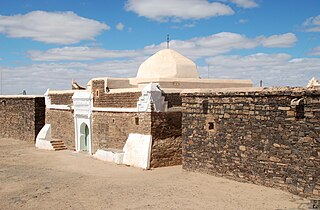
Mohamed Mustafa Ma al-'Aynayn was a Saharan Moorish religious and political leader who fought French and Spanish colonization in North Africa. He was the son of Mohammed Fadil Mamin, and the elder brother of shaykh Saad Bouh, a prominent marabout in Mauritania.
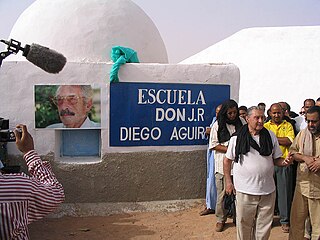
Bir Lehlou is an oasis town in north-eastern Western Sahara, 236 km from Smara, near the Mauritanian border and east of the border wall, in Polisario Front-held territory. It has a pharmacy, a school and a mosque. It is the head of the 5th military region of the Sahrawi Arab Democratic Republic and was the factual temporary capital of SADR until Tifariti became the temporary capital in 2008. It is also the name of a Daïra of the Wilaya of Smara, in the Sahrawi refugee camps.

Tifariti is an oasis town located in north-eastern Western Sahara, east of the Moroccan Berm, 138 km (86 mi) from Smara and 15 km (9 mi) north of the border with Mauritania. It is part of what Polisario Front calls the Liberated Territories and Morocco call the Buffer Zone. It has been the de facto temporary capital of the Sahrawi Arab Democratic Republic since the government moved there in 2008 from Bir Lehlou. It is the headquarters of the 2nd military region of the SADR.
Lemseid or Lamssid(Arabic: لمسيد) is a small town near El-Aaiun in the Saguia el-Hamra part of Western Sahara, close to the Saguia el-Hamra itself.
Ain Ben Tili is a small village-fort in northeast Mauritania, on the border with Western Sahara. It is part of the Tiris Zemmour region.

The Government of Morocco sees Western Sahara as its Southern Provinces. The Moroccan government considers the Polisario Front as a separatist movement given the alleged Moroccan origins of some of its leaders.
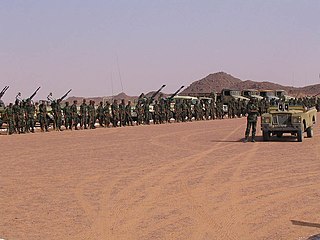
The Western Sahara conflict is an ongoing conflict between the Sahrawi Arab Democratic Republic/Polisario Front and the Kingdom of Morocco. The conflict originated from an insurgency by the Polisario Front against Spanish colonial forces from 1973 to 1975 and the subsequent Western Sahara War against Morocco between 1975 and 1991. Today the conflict is dominated by unarmed civil campaigns of the Polisario Front and their self-proclaimed SADR state to gain fully recognized independence for Western Sahara.

Guelmim-Es Semara was one of the sixteen former regions of Morocco from 1997 to 2015. It covered an area of 122,825 square kilometres (47,423 sq mi) and had a population of 501,921. The regional capital was Guelmim.
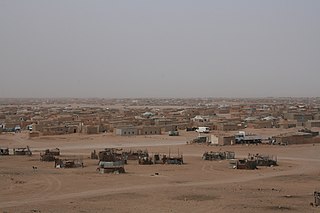
The Sahrawi refugee camps in Tindouf, Algeria, are a collection of refugee camps set up in the Tindouf Province, Algeria in 1975–76 for Sahrawi refugees fleeing from Moroccan forces, who advanced through Western Sahara during the Western Sahara War. With most of the original refugees still living in the camps, the situation is among the most protracted in the world.

The Western Sahara War was an armed struggle between the Sahrawi indigenous Polisario Front and Morocco from 1975 to 1991, being the most significant phase of the Western Sahara conflict. The conflict erupted after the withdrawal of Spain from the Spanish Sahara in accordance with the Madrid Accords, by which it transferred administrative control of the territory to Morocco and Mauritania, but not sovereignty. In late 1975, the Moroccan government organized the Green March of some 350,000 Moroccan citizens, escorted by around 20,000 troops, who entered Western Sahara, trying to establish a Moroccan presence. While at first met with just minor resistance by the Polisario Front, Morocco later engaged a long period of guerrilla warfare with the Sahrawi nationalists. During the late 1970s, the Polisario Front, desiring to establish an independent state in the territory, attempted to fight both Mauritania and Morocco. In 1979, Mauritania withdrew from the conflict after signing a peace treaty with the Polisario Front. The war continued in low intensity throughout the 1980s, though Morocco made several attempts to take the upper hand in 1989–1991. A cease-fire agreement was finally reached between the Polisario Front and Morocco in September 1991. Some sources put the final death toll between 10,000 and 20,000 people.

The Gdeim Izik protest camp was a protest camp in Western Sahara, established on 9 October 2010 and lasting into November that year, with related incidents occurring in the aftermath of its dismantlement on 8 November. The primary focus of the protests was against "ongoing discrimination, poverty and human rights abuses against local citizens".
Mustapha Salma Ould Sidi Mouloud is a former police chief of the Polisario Front, and political dissident.

The 2011 Western Saharan protests began on 25 February 2011 as a reaction to the failure of police to prevent anti-Sahrawi looting in the city of Dakhla, Western Sahara, and blossomed into protests across the territory. They were related to the Gdeim Izik protest camp in Western Sahara established the previous fall, which had resulted in violence between Sahrawi activists and Moroccan security forces and supporters. The protests also purportedly drew inspiration from the Arab Spring and successful revolts in Tunisia and Egypt, though according to some commentators, the Arab Spring proper did not reach Western Sahara.
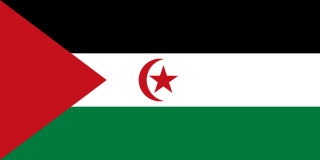
The Sahrawi Arab Democratic Republic, also known as the Sahrawi Republic and Western Sahara, is a partially recognized state, recognised by 46 UN member states, located in the western Maghreb, which claims the non-self-governing territory of Western Sahara, but controls only the easternmost one-fifth of that territory. Between 1884 and 1975, Western Sahara was known as Spanish Sahara, a Spanish colony. The SADR is one of the two African states in which Spanish is a significant language, the other being Equatorial Guinea.
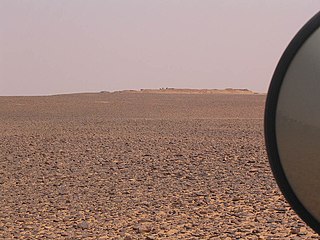
The Battle of Al Mahbes was fought on 14 October 1979 during the war in Western Sahara. The Polisario Front annihilated a battalion of the Royal Moroccan Armed Forces.